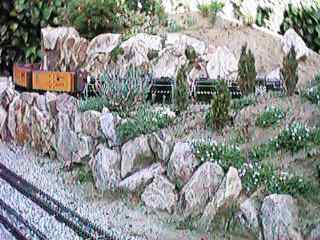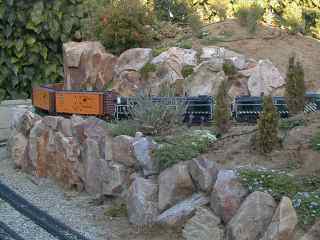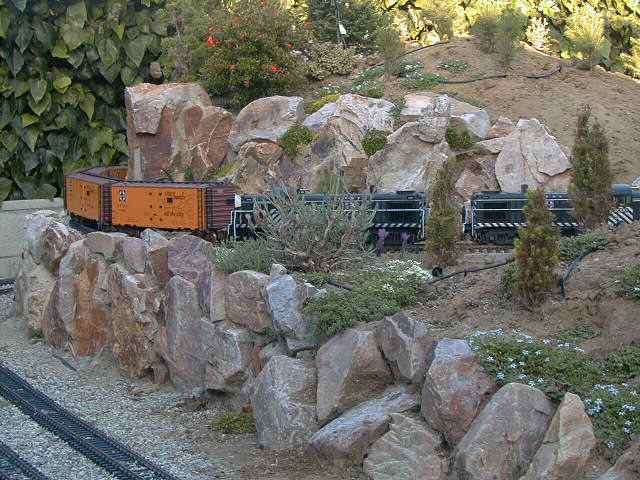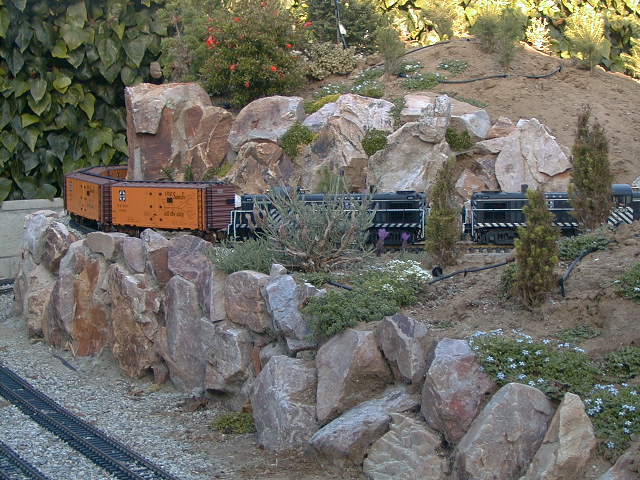This website has been archived from TrainWeb.org/girr to TrainWeb.US/girr.
This website has been archived from TrainWeb.org/girr to TrainWeb.US/girr.
Why is there a digital camera page mixed in with large scale train stuff? In this increasingly digital world, we communicate digitally more and more, and photos are an effective means of communications, especially in World Wide Web pages. Trains and photography have always been closely linked because model trains make such good photographic material. I use digital photos extensively in my web pages to illustrate tips and techniques for large scale trains. Since I've gathered some practical experience on the efficient use of digital photos while creating my pages, I thought that I might share that experience.
In this page, I'll be referencing two particular digital cameras. This is because these are the two cameras that I own (or more technically, my wife owns because she bought them). I do not intend to endorse these two brands or models over any other, nor do I have any commercial or business interest in any camera brand or model.
Our first digital camera was a Casio QV-10a. It was one of the first affordable digital cameras. It has pretty minimal capabilities and I really consider it more of a toy than a real camera. Its color accuracy is poor at best and its images are not very sharp but it does take pictures and it is fairly easy to use. Most of the pictures that are elsewhere on this site were taken with that camera.
The Nikon CoolPix 900 camera was selected by my wife after a months long investigation of all the camera models available based on our own personal list of requirements. This unit borders on the capabilities of a "real" camera although photographers used to the resolution, color accuracy and dynamic range of color positive or negative film will still be disappointed. Nonetheless, my wife has officially forsaken film photography based on this camera. The downside is that all of her pictures will have lower picture quality than a film camera can provide. The upside is that she officially gave me ALL of her film camera equipment. Kodachrome still rules.
[ Top ]
A digital camera is a device that records still photos in some form of electronic memory instead of on film. The memory method most commonly used is called Flash RAM. Some cameras record on rotating media such as a floppy disk. This digital image can then be transferred from the camera to a computer by some method for display, modification, storage or uploading to a web site. Some cameras will also display their images on a built in Liquid Crystal Display (LCD) and/or on a TV set.
The capabilities of digital cameras are increasing incredibly rapidly, a new crop of cameras with new features usually appears about every 3 months. Like computers, your camera will be superseded by a better model almost as soon as you buy it.
[ Top ]
Digital photos are made up of individual dots of color. Each dot is called a pixel and each pixel can usually represent 16 million or more different colors. Many computer display/video adapter combinations have the same capability, although some are limited to thousands or fewer colors. Most computer monitors display their images at 72 pixels per inch, some displays pack a little more into an inch. When the camera images are displayed on a computer monitor, each camera pixel normally maps into one computer monitor pixel. Therefore the size, in pixels, of the camera image maps directly into the physical size of the displayed image. A 640 x 480 camera image will completely fill the screen of a typical VGA computer monitor. 72 dots per inch is a number that comes from print media heritage. On a typical computer monitor, a pixel is the same size as a "point" which is 1/72nd of an inch. Fonts are measured in points, a 12 point font is therefore 1/6" high. This worked out well for computer fonts so computer manufactures adopted that measurement system for displays as it integrates well with traditional print production.
Do not confuse pixel resolution with dot pitch on a computer monitor. The monitor dot pitch is determined by the shadow mask inside the cathode ray tube display and is usually MUCH smaller than a pixel so that one pixel covers many dots on the screen. You can see this if you examine your computer screen with a magnifying glass.
Typical TV sets have much poorer resolution than a computer monitor. Due to a much lower video bandwidth in the video driver circuits, a TV typically can display no more than 350 or so dots on a scan line before the dots fuzz together. This is why the early model personal computers (Apple II, Radio Shack TRS-80 and others) that used a TV set for a display could only display a 40 column screen which is typically 320 pixels wide. Digital pictures taken at higher resolution will loose much of their resolution when scaled to display on a TV set.
The little Casio camera takes pictures at only 320 x 240 pixels in size. These are clearly scaled for efficient display on a TV set as the Casio has a direct video output. For TV display, it does quite well.
There are many "midrange" digital cameras available that display 420 x 280, or 640 x 480, or 720 x 540 pixels. The designers of these cameras are continually trying to balance better resolution against the cost of the CCD (Charge Coupled Device) and memory that it takes to acquire and store the images.
There is currently a crop of cameras out that are in the "megapixel" class. They can record and store images of a million pixels or so. This resolution is typically 1280 x 960 pixels, or 4 times the area than can be displayed on a VGA computer monitor. To see the whole picture at full resolution, you need the largest of the currently available monitors, 21" or more. These monitors cost a bundle, far more than the camera will cost.
If your goal is to produce hard copy of your photos with one of the newer high resolution color printers, you can take advantage of high resolution cameras. The newest printers will print 1440 dpi, or 20 times the resolution of the camera. You can print a megapixel image on a full page and it'll still look pretty good although most printers need the expensive clay paper (at something like $1/sheet) to print that fine.
Most computer monitors have an aspect ratio of 4 to 3. The screen height is 3/4 the screen width. Digital cameras usually use that same aspect ratio. Note that when the new High Definition TV's become popular, some of the new cameras may offer aspect ratios designed to fit the new TV screen sizes. Also expect that all the consumer electronics manufacturer's will provide new VCR's, Camcorders, DVD players, cable boxes and all manner other new stuff so they can most efficiently extract more money from you.
[ Top ]
There are several common formats for the storage of digital images. The most common are GIF, JPEG and BMP. Digital images tend to be large so that considerable engineering work has been done to develop methods to compress the images so that they can be stored without consuming too much memory.
Most cameras are capable of recording in either 24 or 30 bit color. Each of the three recorded colors, red, green and blue, are assigned 8 or 10 bits each. This works out 256 or 1024 possible color values for each recorded color of each pixel. When you multiply the possible color combinations out, you get about 16 or 64 million total colors. Since most computers and microprocessors in the cameras use 32 bit wide data paths, the 24 or 30 bit color information is usually stored in a 32 bit wide word. Therefore each pixel requires 32 bits, or 4 bytes of storage. If you multiply 4 bytes/pixel times a million pixels or so, the high resolution images are 4 megabytes EACH. Obviously something as to be done with all this data because most cameras only have 4 megabytes or less of total memory and therefore could only hold one such picture. This storage format is called "bitmapped" (BMP) and is rarely used in consumer electronics.
Some years ago, CompuServ developed the Graphic Interchange Format (GIF) for the display of images. GIF works pretty well for small pictures as it is very efficient to display, but it is not highly compressed and is limited to 256 total colors. For large, high resolution pictures, GIF files are too big and the color depth is too small.
There was a group of engineers formed called the Joint Pictures Experts Group or JPEG. These people defined a standard by which photographic images could be significantly and efficiently compressed with minimal loss of picture quality. The JPEG standard takes advantage of the fact that even though a computer can theoretically display over 16 million colors, the normal human eye can only distinguish between about 4000 of them. The JPEG standard reduces the total number of colors in an image by blending colors that are very much the same into a single color and the eye can't tell the difference. Then multiple pixels that now have the same colors are referenced together so that the full color information for each pixel does not have to be stored separately. Depending on the degree of compression desired, the image size is reduced to between 2-10% of its original bitmapped size.
JPEG is a "lossy" compression method. That means that once the compression is done, some of the picture information is lost forever and cannot be reconstructed. However, the method works so well that the loss of quality usually cannot be detected by eye except at the extremely high compression levels.
JPEG is also a format understood by every modern web browser so that it the best current method to store photographic images. Most recent cameras store images in JPEG (sometimes called JPG) format. Other cameras, particularly the Casio family, use a proprietary format internal to the camera. Images can be subsequently stored as TIFF files and then converted to JPEG files with other software such as Photo Deluxe, Paint Shop Pro, GraphicConverter, GIFConverter or JPGView.
For line art, JPEG doesn't work too well. It tends to fuzz out distinct lines and adds tone to pure white backgrounds. For line art, the GIF format is better.
[ Top ]
Selecting a digital camera can be a daunting task as there are now so many of them at prices ranging from $200 to $1000 for personal use type cameras and upwards to $20,000 and more for professional models. In this section I will list features that I think are required, important, nice, and not necessary. You can use this information to compare with the features of each camera to see what will meet your needs.
Loads of features come with a price, the better cameras tend to cost more, and to get some features that you think that you need, you may have to buy a camera that also comes with features that you don't need.
Image Size. The first and most distinguishing feature of digital cameras is image size, usually expressed in pixels. For taking pictures to put on web pages, you DO NOT need a megapixel camera. Its images are just too big. They take too long to load and will overfill most user's browser windows. A 640 x 480 image is still marginally too big in most cases. Image size is a powerful selling point though and most newer cameras emphasize the size of the image. Since CCD's and flash RAM have become much cheaper because of the volume of the parts used in digital cameras, getting a camera with a large picture size isn't the economic burden it was only a year ago. Images taken at high resolution can always be scaled back to an appropriate size for web page publishing.
Storage Method. The next most distinguishing characteristic is the image storage method. Most cameras store the images on Flash RAM internal to the camera. The contents of the RAM can then be downloaded over a cable connected to your computer. Some cameras use a removable RAM card that can be plugged into an adapter and then inserted into a PC Card slot on your computer. Most newer laptops have a PC card slot, most desktop machines do not. You need to understand the capabilities of your computer to understand how the camera will interface with it.
The Casio QV-10A camera stores its images in internal flash RAM. I download the images with the Casio supplied software over a cable plugged into a serial port on my Macintosh. I then use the Casio supplied software to save the images in the Macintosh PICT format. I then use GIFConverter to convert the images to JPEG format. This little camera stores images of 320 x 240 pixels in size only, however, these little images are good for web pages because they show sufficient detail yet load quickly.
The Nikon CoolPix 900 stores images in a removable flash memory card in JPEG format. This images can either be downloaded over a serial cable like the Casio into a desktop Macintosh or PC, or the card can be inserted into a Macintosh or PC laptop (with a PC card slot) and mounted as a DOS formatted disk. The Nikon software also allows the card to be mounted as a disk while it is still in the camera. The images can then be displayed or edited. Good pictures can be saved directly on the flash card or copied elsewhere. Reject pictures are simply dragged to the trash.
Some cameras store images on a floppy disk inserted directly into the camera. This disk can then be removed from the camera and inserted directly into a computer.
Lens Quality. The key part of any camera is its lens. More expensive cameras tend to have better lenses, but this is not always the case. For general purpose use, the camera should have an optical zoom lens of at least a 3 to 1 ratio. Digital zoom is a cheap alternate to a long lens, but it just results in lower resolution. The camera should also be adaptable to a wide angle and macro lenses for model railroad photography work.
Battery Life. Digital cameras draw a lot of power and can flatten batteries in a heartbeat. Some cameras will shoot just seven high resolution images on a set of AA batteries. Others will do a lot better. Ask the person selling you the camera the hard questions about battery life and if he/she waffles, look to another brand. Some cameras will accept rechargeable batteries, some will not.
Panasonic is now marketing AA NiCad batteries with an 1100 mAh rating, twice that of traditional AA NiCads. I got a set of these at Price-Costco for about $15 INCLUDING a 5 hour charger. They really do work and seem to outlast alkaline batteries in the Nikon camera.
The Casio camera will not work on NiCad batteries. This is because the camera will crash and hang up if the batteries go dead during the 6 seconds that it takes to record a photo. The NiCad discharge curve can be so abrupt that the camera cannot tell when a set of batteries is nearly dead. If this happens, either the memory gets corrupted or the camera becomes inoperable even if the batteries are replaced. If the Casio crashes, it may be possible to reset it by pressing a certain combination of buttons while turning the camera on. There are some instances where it has to be sent back to a repair depot to be reset.
The Nikon can use NiCad batteries, but the instructions warn that the battery life indicator will be unreliable with NiCads. We've taken over 200 VGA sized pictures on one set of Panasonic NiCads in the Nikon.
Reshoot Cycle Time. Most digital cameras take some measurable time to record their images. This can vary from a second or two to up to 17 seconds. During this time, the camera is busy recording the image (and draining the batteries) and can't take more pictures. If you can take only 3 pictures a minute, you are going to miss a lot of good shots. Strictly for model railroad photography, this doesn't matter much as most shots are static anyway. A film camera with an auto winder can take maybe 2 or 3 pictures per second if it doesn't have to auto focus. Some of the newer digital cameras have multishot capability, although not usually in the high resolution modes.
Low Light Capability. Most digital cameras have good low light capability. CCD's have virtually eliminated film in astronomical imaging due to their excellent sensitivity. The inherent capability of the CCD imager is so good that most cameras operate at fairly fast effective shutter speeds. Often, the cameras will be rated in an ISO equivalent speed. This is the equivalent film speed to get properly exposed pictures at equivalent 35 mm shutter speeds and apertures. The "ISO" rating is a derived number and each manufacturer can calculate it differently.
Focal Length. Most cameras are rated for focal length of an equivalent 35 mm camera where a 50 mm focal length lens produces a "normal" picture. Since the size of the CCD imager changes from camera to camera, a true rating of the focal length would also require that the CCD imager size be specified and then the user would have to do the math. Again, this is a figure of merit that the camera manufacturer calculates. Look for focal lengths that you are familiar with in terms of a 35 mm camera as this is how most of them are rated.
Exposure Controls. Most digital cameras are fully automatic and don't provide much in the way of manual exposure controls. Often, the exposure is completely programmed and you can't control anything except backlight compensation. If you prefer the fully manual operation of a Pentax K-1000, then you won't like a digital camera. The Casio provides two manual exposure ranges (indoor and outdoor) and auto exposes inside those ranges. Backlight compensation on the Casio is done with a + or - button on the camera in half-stop steps up to 2.5 stops. The Nikon provides +/- 2 stops in one stop steps, but its a pain in the backside to change it you have to dive deeply into menus on the LCD screen.
Aperture Control. Most digital cameras do not provide manual aperture control. The exposure range switch on the Casio is really an aperture control (two settings). The Nikon has 3 aperture settings but they are not manually selectable.
Focus Control. Most digital cameras also do not allow manual focus control. Many of the low end cameras are fixed focus anyway. The Casio has fixed focus with a switch on the side for close focus. The Nikon provides 945 step auto focus (which is probably excessive) which runs continually when the LCD display is on to keep the image on the LCD in focus. The Nikon also provides manual focus settings of "near" and "far" for the occasions where the auto focus system can find nothing to focus on. The "near" mode also allows close focus for macro work. The camera will focus down to about 6" in the close focus mode.
[ Top ]
Digital cameras are an ideal source of images for web pages. The resolution of the cameras match or exceed the capabilities of most monitors and the process is quick. A batch of pictures can be taken, evaluated and retaken if necessary while a scene is still available.
Pictures should either be taken in the size that they will be displayed or downsized with software to the intended display size BEFORE the pictures are uploaded to a web server. Images can be resized by HTML commands, but this is inefficient. The whole large image must be downloaded over the network and then resized by the user's browser and this takes unnecessary time.
Image quality varies by camera. Our little Casio takes acceptable, but not great pictures. The Nikon does much better.
 This picture
is typical of the images that come off the Casio QV-10A. It is not
particularly sharp and the color rendition is not particularly
true, but it does the job. The small 320 x 240 images don't fill
the width of a page and text can be wrapped around them. This image
is 28.8K in size and is saved with low JPEG quality.
This picture
is typical of the images that come off the Casio QV-10A. It is not
particularly sharp and the color rendition is not particularly
true, but it does the job. The small 320 x 240 images don't fill
the width of a page and text can be wrapped around them. This image
is 28.8K in size and is saved with low JPEG quality.
 This image
was taken with the Nikon CoolPix 900 at the same time with the zoom
set to cover the same field of view as the Casio. The original 640
x 480 image was shrunk to 320 x 240 using GraphicConverter and the
image was saved as a low quality JPG. This image is 24K in size.
Note that the color rendition is smoother and more color is
apparent, especially the pink color of the quartzite in the rock
wall. The sun lit ivy in the upper right washes out to white in the
Casio image but still retains its color in the Nikon image. The
overall image sharpness is much better as well.
This image
was taken with the Nikon CoolPix 900 at the same time with the zoom
set to cover the same field of view as the Casio. The original 640
x 480 image was shrunk to 320 x 240 using GraphicConverter and the
image was saved as a low quality JPG. This image is 24K in size.
Note that the color rendition is smoother and more color is
apparent, especially the pink color of the quartzite in the rock
wall. The sun lit ivy in the upper right washes out to white in the
Casio image but still retains its color in the Nikon image. The
overall image sharpness is much better as well.

This image is the original 640 x 480 version of the image above saved in JPEG low quality. This image is too big to allow text to be neatly wrapped around the picture in browser windows that will fit on smaller computer monitors, but the image quality is much better. There is no free lunch. This image is 67.2K in size.

This image is the version that was stored in the camera in 640 x 480 size with normal JPEG quality. It is somewhat clearer than the low quality image above but it is not a lot better. This image 81.3K in size. You many have noted that the larger pictures loaded slower than the smaller ones. While this extra delay is acceptable once in awhile, if all your web pictures are this big, the people viewing your pages will get bored and frustrated waiting for them to load.
For those of you that are REALLY interested in what the various resolutions and qualities of the images stored by the Nikon are, the following buttons lead to more images. These were taken about a week later than the images above but at the same time of the day in similar light.
Since some of these images are really large, I've provided links to the actual images so that you don't have to download the ones that you are not interested in seeing.
30 Oct 1999.